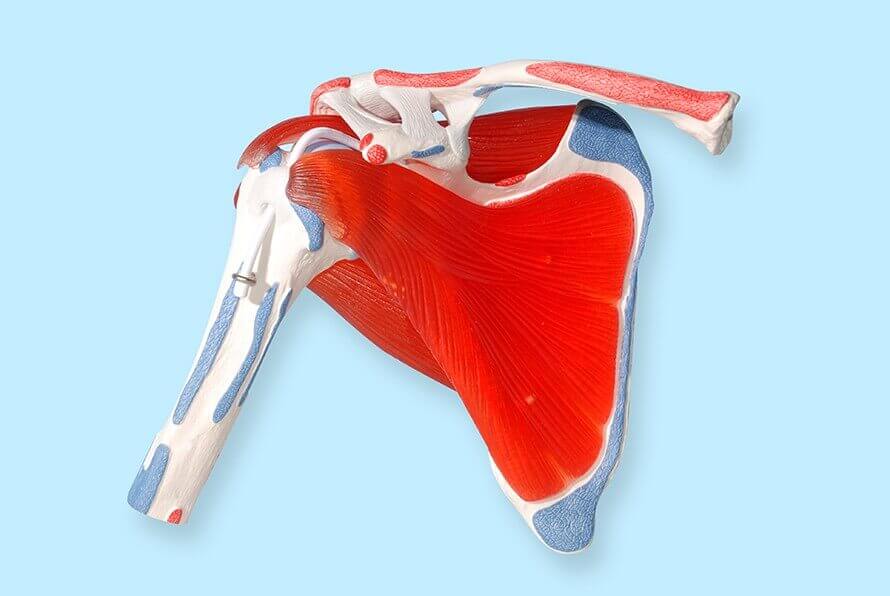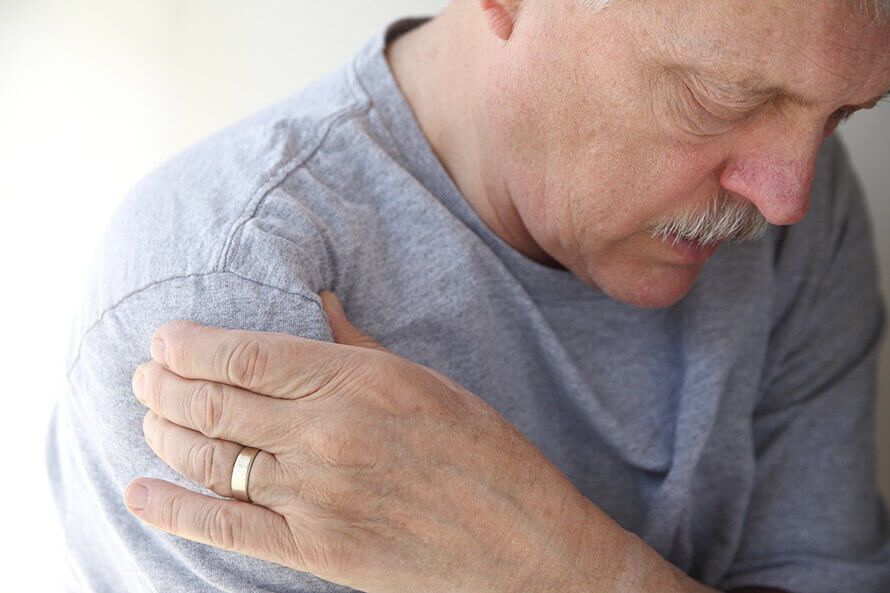
The rotator cuff is a group of muscles and tendons that surround the shoulder joint, keeping the top of your upper arm bone (humerus) firmly within the shoulder blade (scapula) socket. The rotator cuff tendons provide stability to the shoulder, while the muscles allow the shoulder to rotate.
Rotator cuff injuries are extremely common and the rotator cuff is the most common cause of shoulder pain. A rotator cuff injury can cause a dull ache in the shoulder that often radiates down the outside part of the upper arm. When the tendon has a tear, the shoulder becomes weaker and often results in discomfort and difficulty when attempting even the simplest of activities or when just trying to sleep.
Who is mostly affected by rotator cuff tears?

While people of all ages can be susceptible to rotator tears, those that seem to be most vulnerable are athletes, particularly rowers, tennis players and baseball pitchers, as well as people who repeatedly perform overhead motions in their job, such as painters and carpenters. Because rotator cuff tears are most frequently caused by “wear and tear” that goes along with aging, people over the age of 40 are at the greatest risk.
Although younger people can experience tears caused by overhead work or frequent athletic activity, the majority of tears in children and young adults are typically a result of some type of traumatic incident, such as a fall or car wreck.
The most common rotator cuff injuries include:
- Tendinosis – which is the most common cause of shoulder pain
- Tendonitis – which is most common among athletes who do the same repetitive motions day in and day out, and who may push themselves too hard regardless of any pain or discomfort they experience
- Partial Tears of the rotator cuff
- Full Thickness tears of the rotator cuff
- Calcific Tendonitis – which are calcium deposits in the rotator cuff
- Subacromial Impingement – a pinching of the rotator cuff between the humerus and the scapula
Symptoms
The most common symptoms of a rotator cuff tear include:
- Pain at rest and at night, particularly if lying on the affected shoulder
- Pain when lifting and lowering the arm or when doing specific movements
- Weakness when lifting or rotating the arm
- A crackling sensation when moving the shoulder in certain positions
Tears that happen suddenly, such as from a fall or car accident, usually cause intense pain. People in such situations may experience a snapping sensation and immediate weakness in their shoulder and upper arm.
Causes
There are two main causes of rotator tears: injury and degeneration.
Acute tear due to injury
If a person lifts an object that is too heavy while simultaneously doing a jerking motion, they can easily tear their rotator cuff. Additionally, a person can sustain the injury by a simple fall which they land awkwardly on their shoulder. While these aren’t the only ways a person can fall victim to an acute rotator cuff tear, these scenarios are common.
If a person falls or suffers some type of injury that results in some level of weakness, loss of motion and shoulder pain then they should seek treatment from a specialist as soon as possible. When dealing with large traumatic rotator cuff tears, most orthopedic surgeons prefer their patients to undergo surgical treatment sooner than later. The reasoning behind this is because the patient’s tissue is most likely normal prior to the traumatic incident; therefore, the patient’s results of surgery are most likely to be successful in regards of strength and range of motion improvement, as well as the elimination of pain.
Degenerative tear
The majority of tears are the result of people wearing down their tendon over time. The degeneration naturally occurs through the years as people age. The most common tears occur in the person’s dominant arm. If a person is experiencing a degenerative tear in one shoulder, they are at greater risk of experiencing a rotator tear in the opposite shoulder as well. There are numerous factors that contribute to chronic degenerative rotator cuff tears, including the following:
- Repetitive stress – Repeating the same shoulder motions over and over can inflict a great amount of stress on rotator cuff muscles and tendons. Athletes who perform repetitive motions – such as rowers, tennis players, baseball pitchers and weight lifters – are often at risk for overuse tears.
- Lack of blood supply – The blood supply in rotator cuff tendons lessens as people get older. The lack of blood supply hinders the body’s natural ability to repair tendon damage, which can ultimately result in a tendon tear.
- Bone spurs – Bone spurs, which are bone overgrowth, often develop on the underside of the acromion bone. When arms are raised, the spurs rub on the rotator cuff tendon. This condition is called shoulder impingement, and over time will weaken the tendon and make it more likely to tear.
Types of Tears
When one or more of the rotator cuff tendons is torn, the tendon no longer fully attaches to the head of the humerus, the upper arm bone. Most tears occur in the supraspinatus muscle and tendon, but other parts of the rotator cuff may also be involved.
In many cases, torn tendons begin by fraying. As the damage progresses, the tendon can completely tear, sometimes with lifting a heavy object.
There are different types of tears.
- Partial Tear – This type of tear has peeled off the bone anywhere from a small degree to a high grade partial tear that is not far from a complete full thickness tear.
- Full-Thickness Tear – This type of tear is also called a complete tear. In many cases, tendons tear off where they attach to the head of the humerus. With a full-thickness tear, there is basically a hole in the tendon.
Size of tears
Rotator cuff tears are often referenced by the size (small, medium or large) of the tear, which is determined by the following criteria:
- Small rotator cuff tear – tears that are less than 1 cm in size
- Medium rotator cuff tear – 1-3cm in size
- Large rotator cuff tear – 3-5 cm in size
- Massive rotator cuff tear – greater than 5 cm
Treatment options
Many people recover from rotator cuff disease with physical therapy exercises that improve flexibility and strengthen the muscles that surround the shoulder joint.
When rotator cuff tears occur as a result of a single injury, a medical expert should assess the injury as soon as possible. Extensive rotator cuff tears may require surgical repair, transfer of alternative tendons or joint replacement.
When to seek treatment

Rotator cuff tears that go untreated can potentially result in further damage as it can get larger over time, especially if the person continues to use the affected side despite the pain. Early treatment can prevent the symptoms from worsening.
AOKC Houston Knee Pain SpecialistsThere are several treatment options for a rotator tear, and the ideal option varies from person to person. But the end goal of any and every treatment plan is the same: reduce the pain and discomfort while restoring function and mobility.
Before determining the appropriate treatment plan for any individual, a physician will consider the patient’s age, activity level, medical history, overall general health, and the type and severity of their tear. There is no evidence of patients with degenerative rotator cuff tears having better surgery results if their surgery is performed sooner rather than later if the patient’s condition is being monitored. Therefore, many doctors often prefer having their patients try nonsurgical management before opting for surgery.
Nonsurgical treatment
Nearly 50 percent of patients are able to improve their shoulder function and be relieved of their pain through nonsurgical management. While the function and mobility of the shoulder can often be repaired through such treatment, it is important to note that the strength of the shoulder does not typically improve unless the patient undergoes surgery when a tear is present.
Nonsurgical treatment options may include:
- Rest – Many doctors will recommend their patients to rest and limit any activities that require overhead motions.
- A sling – Doctors may recommend their patient wear a sling as a way to keep the shoulder still protected.
- Non-steroidal anti-inflammatory medication (NSAIDs) - Drugs like ibuprofen, naproxen, and prescription strength anti-inflammatories reduce pain and swelling.
- Strengthening exercises and physical therapy – Specific exercises will restore movement and shoulder strength. Most exercise programs include stretches to improve flexibility and range of motion. Strengthening the muscles that support shoulder can relieve pain and prevent further injury.
- Steroid injection – An injection of a local anesthetic and an anti-inflammatory, such as cortisone, may be recommended in conjunction with NSAIDs and physical therapy.
Treating the rotator cuff injury non-surgically with Physical Therapy
Physical therapy can oftentimes be used as a tool to find the root of a shoulder problem, and to help determine whether or not surgery will indeed help the patient. Exercises can improve the areas of weakness and strengthen the muscles around a torn tendon. If a patient’s shoulder improves with physical therapy, then it may be determined to forgo surgery. Regardless of whether or not a patient proceeds with the surgical route, they will require some sort of rehabilitation and/or physical therapy.
The pros of physical therapy:
- Physical therapy can improve a person’s range of motion, allowing the shoulder to move easier and without minimal, if any, pain
- With physical therapy, patients learn how to properly lift and carry objects and do other simple activities while focusing on using the muscles that aren’t injured as a way to protect the area(s) that are hurt.
- After a few sessions of physical therapy, most exercises can be done in the comfort of a patient’s home, allowing patients the ability to work on their rehabilitation as often as possible.
Degenerative rotator cuff tears
Degenerative tears, which develop slowly due to overuse, cause pain and arm weakness. People often experience pain in their shoulder when lifting their arm to the side, or pain that moves down their arm. At first, the pain may be mild and only present when lifting their arm over your head. Over-the-counter medication, such as aspirin or ibuprofen, may relieve the pain for a while. However, the pain may become more noticeable at rest, and no longer treatable with over-the-counter medications. The pain and weakness in the shoulder can make simple, routine activities – such as blow drying hair or reaching overhead in the pantry – extremely difficult.
Surgery options
Surgery to repair a torn rotator cuff most often involves re-attaching the tendon to the head of humerus (upper arm bone). A partial tear, however, may need only a trimming or smoothing procedure called a debridement. A complete tear within the thickest part of the tendon is repaired by stitching the two sides back together.


